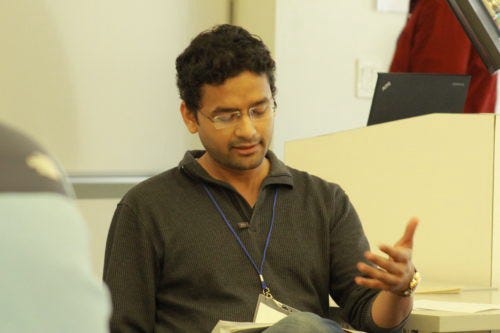Hindutva and Neoliberalism: Left Forum Day2
A panel on India’s neoliberal government on Saturday afternoon at Left Forum explained the processes by which the country’s right wing suppresses dissent.
The panelists, Siddhartha Mitra, Anindya Dey, and Rajeev Ravisankar, delivered their talk: The Battle for Democracy in a Time of Neo-liberal Fascism in a classroom on the fourth floor of the John Jay College of Criminal Justice in Manhattan.
Dey opened the discussion by giving an overview of the Bharatiya Janata Party, or BJP and the Rashtriya Swayamsevak Sangh, or RSS. The two have been closely tied for decades.
“You can look at the evolution of the RSS in three phases,” Dey said. “First is the pre independence period, before 1947. Then the post independence period- where the group’s role was more closely tied to the state- 1947 to 1975. They were marginalized for these periods. But in 1975, something happened- Indira Ghandhi declared a 21 month state of emergency.”
The Emergency, as it’s known now, was the spark for the third phase in the evolution of the RSS. All marginalized groups in India joined together to combat the authoritarian powers Ghandhi claimed, and they all grew stronger because of it.
“After the emergency, RSS and its affiliates carved out space in mainstream politics,” Dey said. “And they only gained more power after 1989.”
In 1989, the Mandal Commission found that the caste system in India was harming the country’s less fortunate. To fix this problem, the Commission called for affirmative action. The upper castes pushed back, hard, and the RSS and the BJP allied with the push-back.
The culmination of this alliance was the 2014 election of Prime Minister Narendra Modi, a right wing former governor of the province of Gurjarat and the tacit endorser of the anti-Muslim riots in that area in 2002.
Modi, Dey explained, has forged an alliance between extreme Hindu nationalism and the corporate state in India. This alliance has destroyed spaces of tolerance in the country.
Mitra followed up on the theme of ideological spaces. He described Indian politics as a version of the ten-headed Hindu god Ravana.
“There are different Indias and different political spaces in the country,” he explained.
However, Hindu nationalism, or Hindutva, wants to cut off all the other nine heads. One way they are doing this, Mitra explained, is by defining the caste system as an ever-present reality in Indian society.
This requires revising and changing the historical record, he explained.
“They’ve cracked down on dissent and revisionist ideas,” Mitra said. “Stopping people who oppose Hindutva is also important for the nationalist project.”
Support for Hindutva is a problem across the United States, Ravisankar explained, and it’s usually not recognized as such.
There is a lack of awareness among US progressives on the reality of Hindutva. Many on the left in the US are ignorant of the realities of the nationalist project.
Further complicating the situation in the US, Ravisankar said, is that many Indian migrants to the US have been in the higher castes. Therefore support for the upper caste right is high among the Indian diaspora in this country.
“Caste and class dynamics of Indian migrants explains support of neo-liberal Hindu brahminical hegemony,” he said. “Caste orientation is essential to consider… Hindutva is a source of civic and national pride.”
Hindutva supporters use multicultural spaces in the US to propagate their ideology as well, Ravisankar explained, manipulating the language of inclusion and tolerance to promote their project of destroying those principles in India.
One note of hope was sounded by Dey, though, in the face of a strong and pervasive right wing propaganda machine.
“It’s not completely hopeless,” he said. “Groups on the left in India are thinking of coming together with broad based ideas…. There will be a lot of resistance to Modi, the RSS, and the BJP.”






